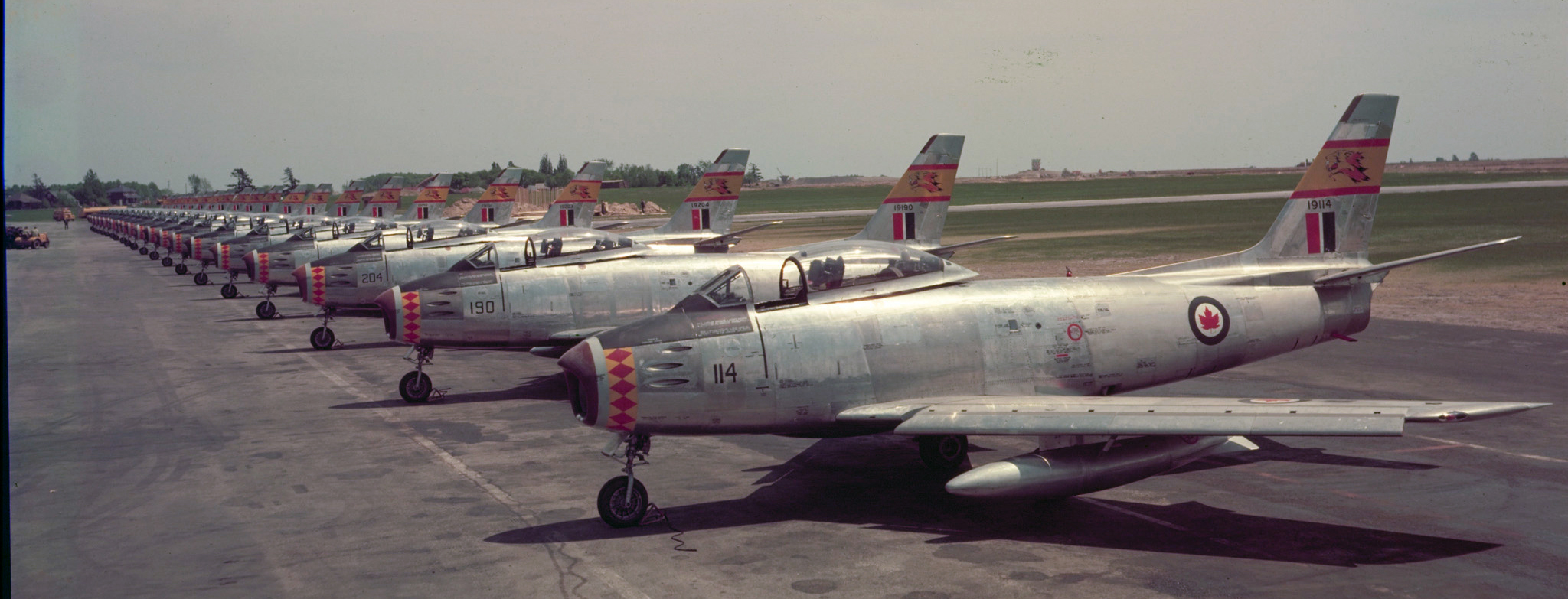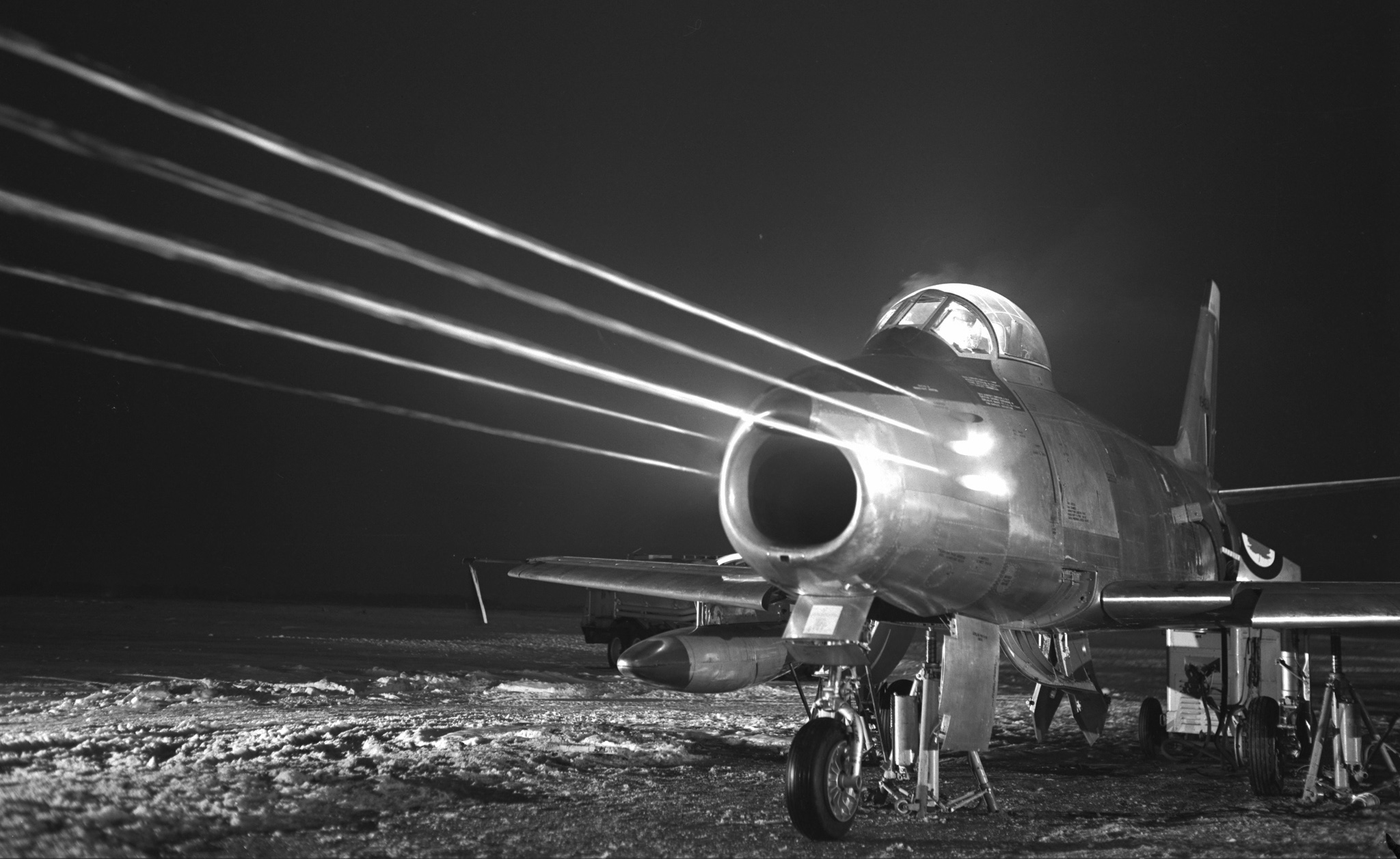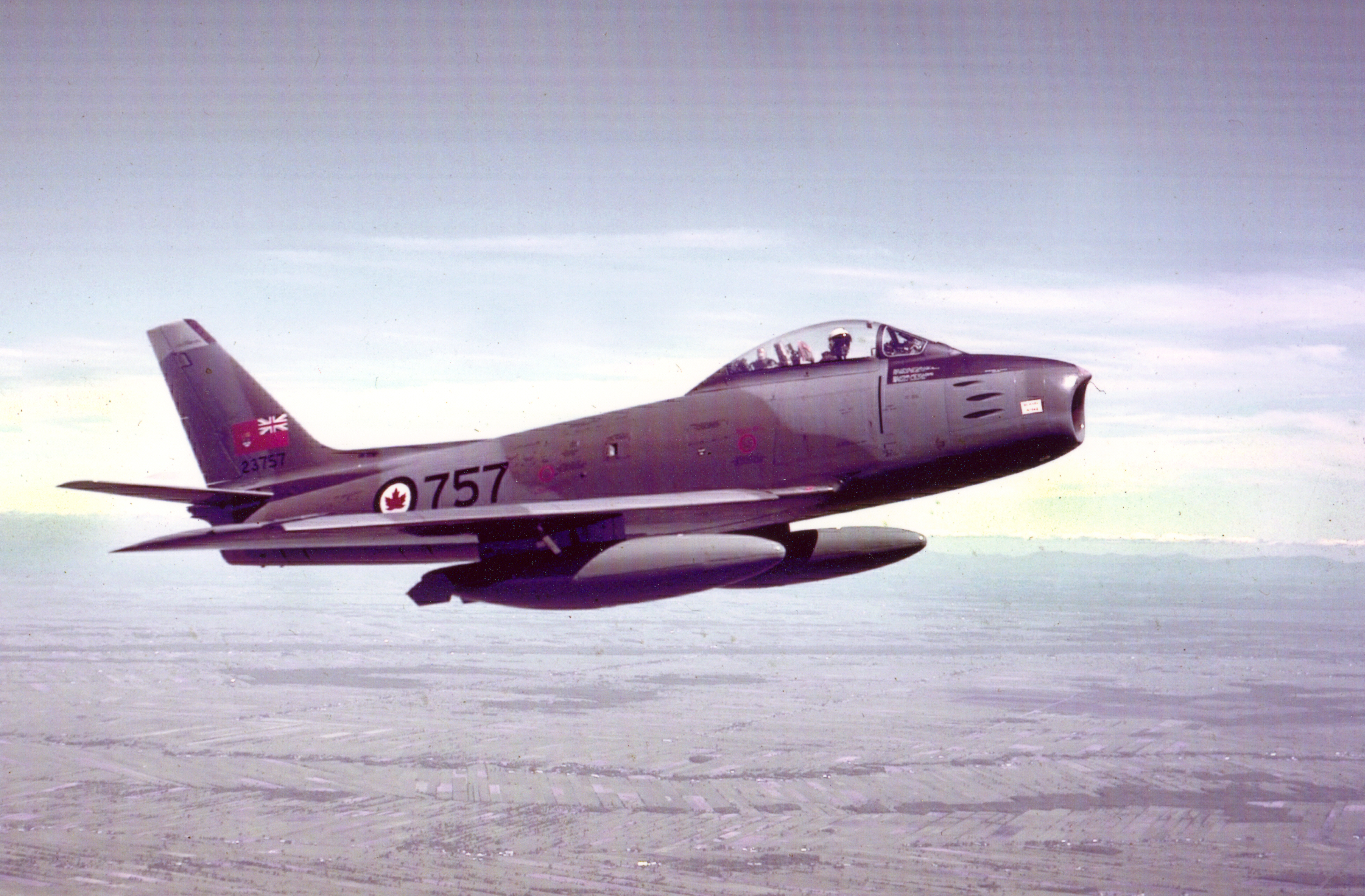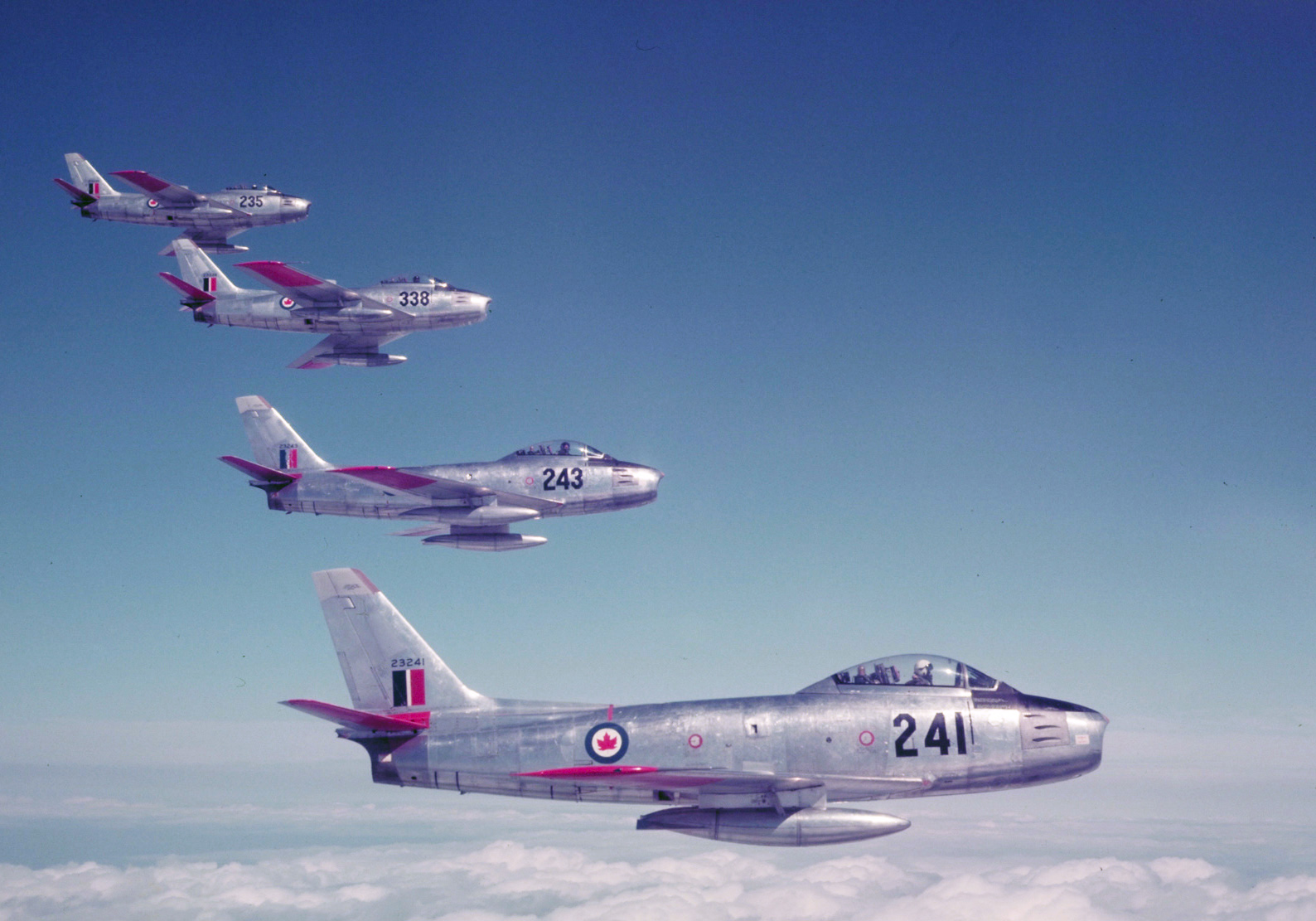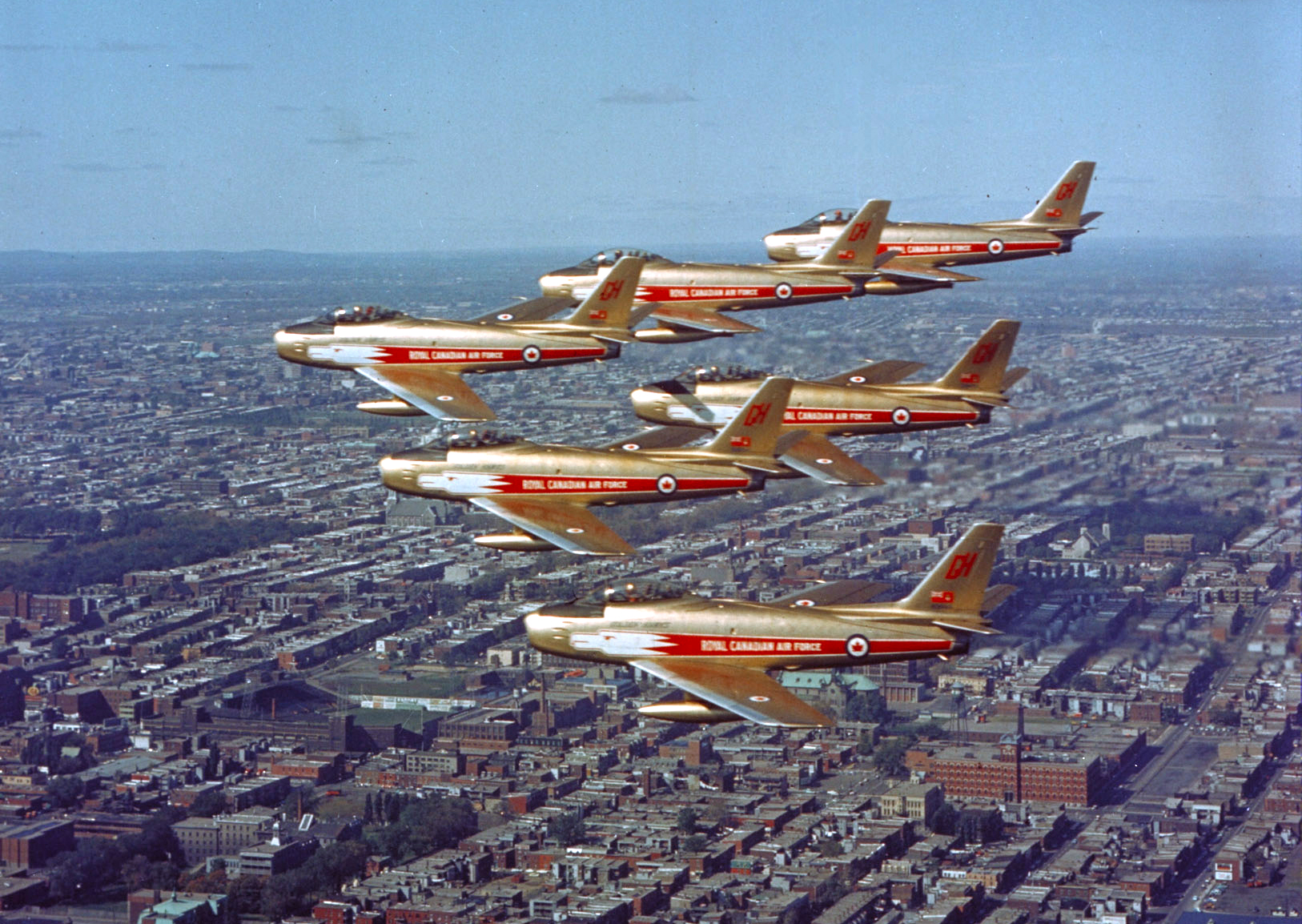Canadair F-86 Sabre

Overview
Overview
The North American F-86 Sabre was first flown on October 1, 1947, and quickly proved a highly successful design. With the formation of NATO in 1949, the Canadian government made the decision to re-equip the RCAF’s front-line fighter squadrons with modern aircraft and selected the F-86 Sabre. Consequently, an agreement was reached between North American and Canadair Ltd. of Montréal to manufacture 100 F-86As in Canada. After the first prototype, designated CL-13 Sabre Mk 1, Canadair immediately began production in earnest with an improved Mk 2 model. The Mk 2 was essentially an F-86E with an “all flying” tail plane to provide better flying characteristics, as well as a flat windscreen. The next major production model was the Mk 4—which was originally to have been powered by an Orenda-designed engine but, to retain commonality with the F-86E, it also carried the J47-GE-13.
Various design improvements were incorporated throughout the aircraft and 438 Mk 4 Sabres rolled off the assembly lines. The Mk 5 Sabre was the first production model with a Canadian engine, using the Orenda 10 version and rated at 6,355-lb thrust. The bigger Orenda engine necessitated a larger diameter opening in fuselage frames and stronger engine mounts. An important structural modification was the introduction of a fixed leading edge to replace the automatic slats on earlier versions. This change was designed to enhance the high altitude performance of the aircraft. Small wing fences were also introduced at the 70 per cent span position. These modifications were successful, but also resulted in a corresponding decrease in low-speed handling characteristics. After the construction of 370 Mk 5 aircraft, Canadair moved on to the final (and best) version, the Mk 6.
This version carried the two-stage Orenda 14 engine with a 7,275 lb thrust rating. The wing leading slats were re-introduced, while retaining portions of the Mk 5 wing configuration. The Mk 6 therefore acquired superb combat manoeuvring. With this combination of engine and aerodynamics, the Mark 6 was widely regarded as the best “dog-fighter” of its era. The Golden Hawks teams of the RCAF initially flew Mk 5 aircraft, but were soon equipped with the excellent Mk 6 aircraft.
| Designation | F-86 |
| Model number | CL-13 |
| Marks | Mk 1, 2, 3, 4, 5, 6 |
| Role | Fighter |
| Taken on strength | 1950 |
| Struck off strength | 1970 |
| Number | 1,184 |
| Service | RCAF, Canadian Armed Forces |
|---|
Source: Canadian Combat and Support Aircraft: A Military Compendium by T.F.J. Leversedge © 2007. Translated and reproduced with permission of the author.
Technical Specifications (Mk 2)
Technical Specifications (Mk 2)
| Manufacturer | North American, designed and built by Canadair |
| Crew / passengers | One pilot in ejection seat |
|---|---|
| Powerplant | General Electric J-47-GE-13 turbojet at 5,200 lb (2,360 kg) thrust |
| Maximum speed | 590 mph (949 km/h) |
| Service ceiling | 47,200 ft (14 386 m) |
| Empty weight | 10,434 lb (4,737 kg) |
| Gross weight | 14,577 lb (6,618 kg) |
| Span | 37 ft 11½ in (11.57 m) |
| Length | 37 ft 6 in (11.43 m) |
| Height | 14 ft 9 in (4.50 m) |
| Wing area | 287.9 sq ft (26.74 m2) |
| Armament | Six .50-cal machine guns plus provisions for tanks, bombs and rockets (unguided) |
| Cost | Unknown |
Source: Canadian Combat and Support Aircraft: A Military Compendium by T.F.J. Leversedge © 2007. Translated and reproduced with permission of the author.
Technical Specifications (Mk 5)
Technical Specifications (Mk 5)
| Manufacturer | North American, designed and built by Canadair |
| Crew / passengers | One pilot in ejection seat |
|---|---|
| Powerplant | Orenda series 10 turbojet at 6,355 lb (2,883 kg) thrust |
| Maximum speed | 605 mph (973 km/h) |
| Service ceiling | 50,700 ft (15,453 m) |
| Empty weight | 10,662 lb (4,840 kg) |
| Gross weight | 14,634 lb (6,644 kg) |
| Span | 37 ft 11½ in (11.57 m) |
| Length | 37 ft 6 in (11.43 m) |
| Height | 14 ft 9 in (4.50 m) |
| Wing area | 302.3 sq ft (28.08 m2) |
| Armament | Six .50-cal machine guns plus provisions for tanks, bombs and rockets (unguided) |
| Cost | Unknown |
Source: Canadian Combat and Support Aircraft: A Military Compendium by T.F.J. Leversedge © 2007. Translated and reproduced with permission of the author.
Technical Specifications (Mk 6)
Technical Specifications (Mk 6)
| Manufacturer | North American, designed and built by Canadair |
| Crew / passengers | One pilot in ejection seat |
|---|---|
| Powerplant | Orenda series 14 turbojet at 7,275 lb (3,302 kg) thrust |
| Maximum speed | 606 mph (975 km/h) |
| Cruising speed | 489 mph (787 km/h) |
| Service ceiling | 54,000 ft (16,458 m) |
| Range | 1,486 mi (2,391 km) |
| Empty weight | 10,618 lb (4,818 kg) |
| Gross weight | 14,613 lb (6,634 kg) |
| Span | 37 ft 11½ in (11.57 m) |
| Length | 37 ft 6 in (11.43 m) |
| Height | 14 ft 9 in (4.50 m) |
| Wing area | 287.9 sq ft (26.74 m2) |
| Armament | Six .50-cal machine guns plus provisions for tanks, bombs and rockets (unguided) |
| Cost | $360,000 |
Source: Canadian Combat and Support Aircraft: A Military Compendium by T.F.J. Leversedge © 2007. Translated and reproduced with permission of the author.
